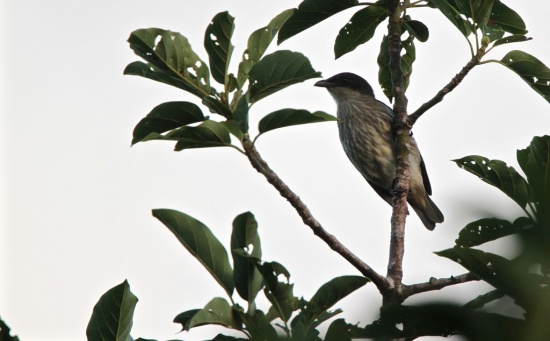Alternative name: Striped Starling
- Aplonis tabuensis
Identification
20cm (7¾ in). A medium-sized brown or brownish starling with a stocky appearance, a short-tail and a relatively short bill. Strong geographical variations.
- Brown above, darker and with violet iridescence on crown and forehead
- Dark brown wing with pale patch on closed wing
- Brown tail
- Paler buffy below with white streaks on throat and breast
- Red-brown eye
- Dark horn-brown bill
- Dark brown legs
Sexes similar. Juveniles undescribed.
Variations
- brunnescens with smaller, thinner bill, no iridescence and red-brown or dark brown eye
- tenebrosa is dark sooty brown
- nesiotes darker than nominate (but not as dark as tenebrosa) and with yellow eye
- pachyrampha with dark brown underparts and brown eye
- tucopiae uniformly brown without streaking, eye brown or yellowish
- rotumae is duller than nominate, has an olivaceous tinge, more white on lower belly, a slender and less curved bill and yellow eyes
- fortunae smaller than nominate, browner back and paler and more streaked underparts, eye yellow
- brevirostris smaller and darker than nominate, with prominent streaking below, stubby pale brown bill and yellow eye
- tutuilae larger than brevirostris, darker underparts, large bill, yellow eye
- manuae darker back than tutuilae, no wing patch, dark grey brown underparts without streaks, small bill, yellow eye
- vitiensis with thinner bill than nominate, pronounced streaking, paler wing patch, eye colour varies from brown (north and west islands of range) to yellow
Distribution
Found on islands in the Pacific around western Polynesia and to Santa Cruz (Solomon Islands).
Widespread and common on many islands. Threats include habitat loss (which may not be significant as once thought, as the Starlings adapt quickly) and introduced predators. A new threat comes from introduced bird species, such as Mynahs and Common Starlings.
Taxonomy
Subspecies
Twelve subspecies recognized[1]:
- A. t. tabuensis on Lau Archipelago (Fiji) and southern Tonga Islands
- A. t. brunnescens on Niue, east of Tonga
- A. t. tenebrosa on Tafahi and Niuatoputapu, northern Tonga
- A. t. nesiotes on Niuafo'ou in northern Tonga
- A. t. vitiensis on Fiji (except in the east)
- A. t. manuae on Manua Islands, Amercian Samoa
- A. t. tutuilae on Tutuila Island, American Samoa
- A. t. brevirostris on Samoa
- A. t. fortunae on Wallis and Futuna Islands
- A. t. rotumae on Rotuma Island, north of Fiji
- A. t. tucopiae on Tikopia in southeast Santa Cruz Islands
- A. t. pachyrampha on Tinakula Group and Swallow Islands, Santa Cruz Islands
Habitat
Common in all kinds of habitats, provided a few trees or bushes are present. On larger islands usually occurs in forest and well-wooded secondary habitat. On islands where Samoan Starling occurs confined to high forest.
Behaviour
Diet
Feeds mainly on fruit but takes also insects.
Forages actively and often in acrobatic fashion in all levels. Usually seen in small flocks, sometimes singly.
Breeding
Breeding season from March to early September in Samoa, recorded in August on Niue. The nest is placed in a tree hole or in a broken stump of a coconut palm. Lays 2 - 3 blue, speckled brown eggs.
Movements
A resident species.
References
- Clements, J. F., P. C. Rasmussen, T. S. Schulenberg, M. J. Iliff, T. A. Fredericks, J. A. Gerbracht, D. Lepage, A. Spencer, S. M. Billerman, B. L. Sullivan, and C. L. Wood. 2023. The eBird/Clements checklist of Birds of the World: v2023. Downloaded from https://www.birds.cornell.edu/clementschecklist/download/
- Del Hoyo, J, A Elliott, and D Christie, eds. 2009. Handbook of the Birds of the World. Volume 14: Bush-shrikes to Old World Sparrows. Barcelona: Lynx Edicions. ISBN 978-8496553507
Recommended Citation
- BirdForum Opus contributors. (2025) Polynesian Starling. In: BirdForum, the forum for wild birds and birding. Retrieved 13 May 2025 from https://www.birdforum.net/opus/Polynesian_Starling
External Links
GSearch checked for 2020 platform.1





